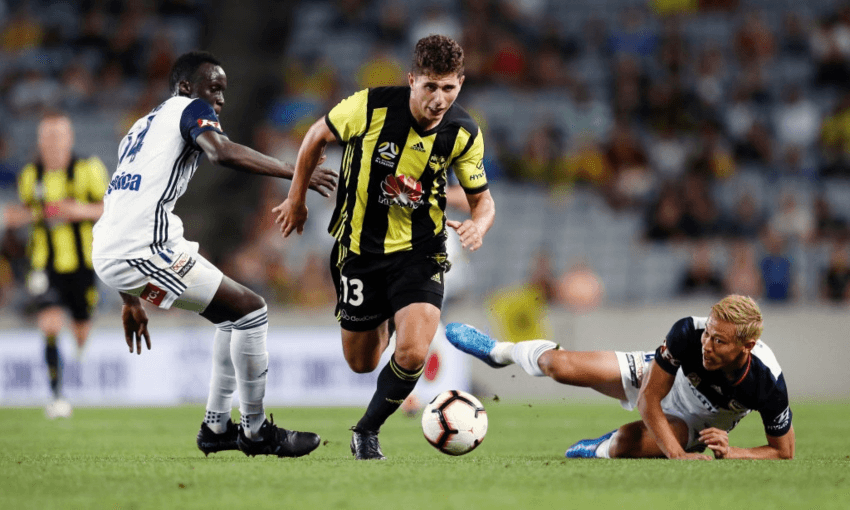For once, the Wellington Phoenix are actually cool. Alex Braae was part of a record crowd that went along to see them in Auckland last night.
“Have the Phoenix always passed it around this much?” I was asking my mate, who was as bewildered as I was about what was playing out in front of us. The energetic vigour was coming from the black and yellow shirts, shaping pretty triangles all over Eden Park with the ball, and looking threatening and creative. They were up against the Melbourne Victory, 2nd in the A-League, with a long, imposing record of success. And the Phoenix, so recently little more than the butt of a not particularly funny joke, were the ones playing the actual football.
Neither of us had ever actually been to a Phoenix game, despite both growing up in Wellington. I’d barely even watched them on the telly, and every time I did, they were rubbish. As exiles in Auckland, we went along on a whim of vague hometown patriotism, and sat in the cheapest seats. Before this season I had a half-formed, lingering, and perhaps unfair memory of teams playing in Ricki Herbert’s grim bus-parking style. There seemed to be an endlessly revolving cast of forgettable journeymen Australians, and every once in a while something absurdly dysfunctional would happen, like the first owner Terry Serepisos having to sell the club because his property empire was collapsing.
To tell the truth, if you asked me what I thought about the Phoenix before this season, the answer would have been simple – not much at all.
It was a completely different team that ran out at Eden Park. Perhaps it helped that there was a record crowd to play in front of. But when Roy Krishna scored, thrashing a loose ball into the top corner, the roar was huge and genuine. He thumped his chest as he ran towards some yellow shirts in the crowd. It felt inevitable – of course the Phoenix would take the lead, despite playing against a much better side on paper.
When the final whistle blew, I was desperate for more. It wasn’t even that it had finished 1-1 – that seemed like a fair result. It was just that the frenzy had set in during the last half-hour of the game, and it was impossible not to get swept up in it. The Yellow Fever were singing, the huge walk-up crowd of casual fans were hanging on every kick. Perhaps a thousand people stayed behind afterwards, to get a last glimpse and maybe a selfie with a player. Krishna, who grafted away for so many years at Waitakere United before getting finally getting a professional run with a mediocre team in a lowly league, was a popular target for the admiration of the fans. The moment belonged to the long-derided club from Wellington, and they deserved it.
But it will almost certainly never be repeated again. Not like this, at least. There’s an air of impending doom hanging over the Phoenix – a sure knowledge that next season will always be worse than this season. For a couple of years in a row now, they’ve proved that right. Last season got so farcical that the assistant coach and his player son quite literally grabbed their ball and went home in a huff. Crowds were poor week after week, everything on and off the field was terrible, and when the A-League threatened to kick the club out, by rights they probably should have. The axe still lingers over their ongoing existence, with a license to play in the A-League in place only until the end of next season.
Even this year, with the team playing beautifully and setting the league alight, they’re still only in 6th place. 6th! Out of 10! In what are seemingly the absolute best of times! But it all hangs by a thread, which looks certain to snap soon. Roy Krishna is soon off-contract, and likely to get some seriously decent offers. Coach Mark Rudan is refusing to commit to staying another year. Andrew Durante, older than time itself, is about to have a testimonial dinner put on in honour of his decade of service. Young wunderkinds Sarpreet Singh and Liberato Cacace will surely move up in the world within a few years. The sponsor Huawei is looking at the door – even geopolitical wrangling is conspiring against the Phoenix. It was perhaps fitting that the whole affair was hosted in a stadium currently in massive, ruinous debt.
But somewhere, in some other godforsaken hellhole, the reality of New Zealand’s sporting landscape was being dragged to the surface again. At the same time the Phoenix were painting with joyous colours, the Super Rugby season was starting. A zombie competition, that brings no happiness to anyone except broadcasters, which cannot be killed no matter how many times administrators shoot it, and we’ll still have to talk about it for months to come. An entire season will probably pass without a single, perfect moment to match Krishna’s goal. Super Rugby now only proves one thing: that the sporting gods are real, and they want us to suffer.
The Phoenix too prove the sporting gods are real, in that they have been blessed and cursed by the tantalising sniff of success, but with little power to hold onto it. There are just a few home games left, in what might well turn out to be their final season of football worth watching. See it with your own eyes while you can.




